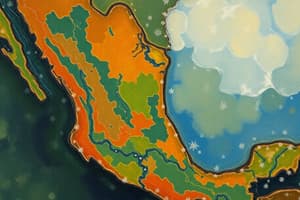Podcast
Questions and Answers
What factors primarily influence climate variations across different regions?
What factors primarily influence climate variations across different regions?
- Human activities and land uses
- Latitude, elevation, and proximity to water bodies (correct)
- Biodiversity and ecosystem interactions
- Geological formations and soil types
Which of these landforms is primarily formed by tectonic activity?
Which of these landforms is primarily formed by tectonic activity?
- Hills
- Lakes
- Plains
- Mountains (correct)
What is the primary process involved in soil formation?
What is the primary process involved in soil formation?
- Agricultural development
- Volcanic eruptions
- Organic material decomposition
- Weathering of rocks (correct)
Which type of natural hazard is NOT typically classified under physical geography?
Which type of natural hazard is NOT typically classified under physical geography?
What role do GIS and remote sensing play in physical geography?
What role do GIS and remote sensing play in physical geography?
Flashcards are hidden until you start studying
Study Notes
Physical Geography
-
Definition
- The branch of geography that deals with the natural environment and physical processes of the Earth.
-
Key Components
-
Landforms
- Mountains, valleys, plains, plateaus, hills.
- Formation processes: tectonic activity, erosion, and weathering.
-
Climate and Weather
- Definition of climate vs. weather.
- Major climate zones: tropical, arid, temperate, polar.
- Factors influencing climate: latitude, elevation, proximity to water bodies.
-
Soils
- Types of soil: sandy, clay, loamy, silty.
- Soil formation processes: weathering of rocks, organic material incorporation.
- Importance of soil in agriculture and ecosystems.
-
Hydrology
- Study of water in the environment.
- Water bodies: rivers, lakes, oceans, aquifers.
- The water cycle: evaporation, condensation, precipitation, infiltration.
-
Biogeography
- Distribution of ecosystems and organisms across the planet.
- Factors influencing species distribution: climate, geology, human activity.
- Biodiversity hotspots and conservation areas.
-
-
Natural Hazards
- Types: earthquakes, volcanoes, tsunamis, hurricanes, floods.
- Causes and effects of natural disasters on physical geography and human societies.
-
Human Interaction
- Impact of human activities on physical geography: urbanization, deforestation, agriculture.
- Climate change effects: global warming, sea-level rise, altered weather patterns.
-
Mapping and Geospatial Technologies
- Use of GIS (Geographic Information Systems) and remote sensing.
- Importance in analyzing and visualizing physical geography data.
Definition
- Physical geography focuses on the Earth's natural environment and the physical processes shaping it.
Key Components
-
Landforms
- Includes mountains, valleys, plains, plateaus, and hills.
- Formed through tectonic activity, erosion, and weathering processes.
-
Climate and Weather
- Distinction between climate (long-term atmospheric conditions) and weather (short-term atmospheric conditions).
- Major climate zones: tropical, arid, temperate, and polar.
- Influencing factors: latitude, elevation, and proximity to water bodies.
-
Soils
- Types of soil consist of sandy, clay, loamy, and silty.
- Soil formation involves weathering of rocks and incorporation of organic material.
- Vital for agriculture and sustaining ecosystems.
-
Hydrology
- Explores the presence and movement of water within the environment.
- Key water bodies include rivers, lakes, oceans, and aquifers.
- The water cycle comprises evaporation, condensation, precipitation, and infiltration.
-
Biogeography
- Examines how ecosystems and organisms are distributed globally.
- Distribution influenced by factors such as climate, geology, and human activities.
- Critical areas include biodiversity hotspots and conservation zones.
-
Natural Hazards
- Types include earthquakes, volcanoes, tsunamis, hurricanes, and floods.
- Understanding the causes and impacts of these hazards on physical geography and societies.
-
Human Interaction
- Human activities like urbanization, deforestation, and agriculture significantly alter physical geography.
- Climate change consequences include global warming, rising sea levels, and shifts in weather patterns.
-
Mapping and Geospatial Technologies
- Utilizes Geographic Information Systems (GIS) and remote sensing for spatial analysis.
- Essential for visualizing and interpreting physical geography data.
Studying That Suits You
Use AI to generate personalized quizzes and flashcards to suit your learning preferences.




